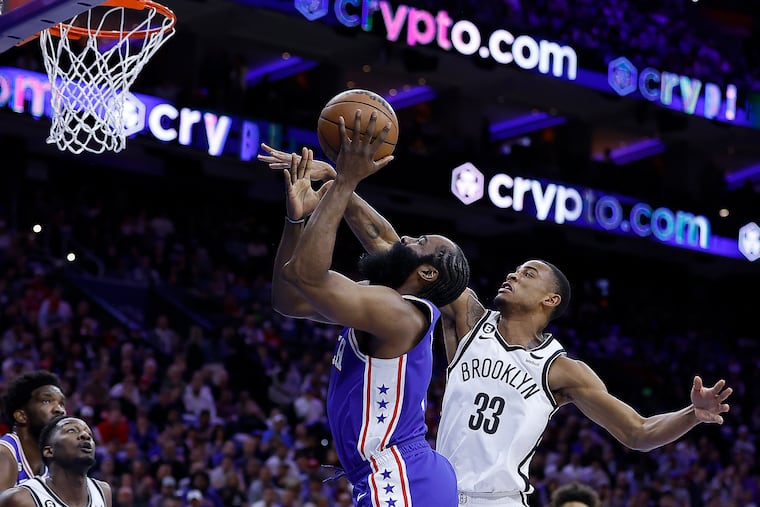James Harden has struggled at the rim, but the Sixers remain unconcerned: ‘He’s just got to finish’
Harden shot 2-of-13 from two-point range in the series’ first two games, including a combined 1-of-7 at the rim and 1-of-5 in the paint’s non-restricted area.

NEW YORK — Less than three minutes into Monday’s Game 2 between the 76ers and Brooklyn Nets, James Harden drove to his left and finished a layup.
It was reasonable to consider the fairly routine play a positive sign, after the Sixers star guard had struggled to score inside the three-point arc in the first-round playoff series’ opening matchup. Instead, that bucket is the outlier so far during a series when Harden has otherwise failed to convert at the rim.
Sixers coach Doc Rivers credited the Nets’ length with challenging those inside shots, as well as those defenders’ commitment to pulling their hands back to dissuade foul calls. The coach added that better offensive spacing by the Sixers in Thursday’s Game 3 at Barclays Center would help Harden unlock that part of his offensive repertoire. Yet Rivers and teammate Tyrese Maxey expressed no panic about Harden’s troubling two-game trend.
“He’s getting there, so he’s just got to finish it,” Maxey said following Wednesday’s practice, when Harden was not made available for interviews. “ … I’m not worried about James making layups.”
» READ MORE: Doc Rivers, Seth Curry acknowledge ‘awkward’ personal matchup in Sixers-Nets playoff series
Harden shot 2-of-13 from two-point range in the series’ first two games, including a combined 1-of-7 at the rim and 1-of-5 in the paint’s nonrestricted area. And though those struggles haven’t deterred a Sixers team up 2-0 on the Nets as the best-of-seven series shifts to Brooklyn, interior forces Robert Williams of the Boston Celtics and Brook Lopez of the Milwaukee Bucks would likely await the Sixers in the coming playoff rounds.
As a primary ballhandler, finishing inside requires initial explosion from Harden to get by his defender, then the combination of craftiness, lift, and physicality to score or draw contact for a free-throw trip. The eye test indicates that aspect of Harden’s game has been spotty since he arrived in Philly at last season’s trade deadline, at least partially because of a hamstring issue that hampered Harden for the better part of two seasons.
Harden connected on 57.6% of his 3.1 attempts at the rim per game during the regular season, and 59.2% of his 3.6 attempts during last season’s Sixers regular-season stint. That figure elevated to 65.9% on 3.7 attempts per game during last season’s playoffs.
Compare that to Harden’s MVP season in 2017-18, when he made 62.4% of his 6.3 shots in that area per game, or when he connected on 62% of his 4.6 attempts after he was traded from the Houston Rockets to Brooklyn in 2020-21. Last season, that figure dipped to 54.4% on 4.6 attempts with the Nets before he was traded to the Sixers.
Rivers initially dismissed a question before Game 2 about any “adjustments” required for Harden to better succeed at the rim, saying “coaches don’t actually adjust the player from playing” and “if it’s a lot of traffic, move it or finish through traffic.” Yet superstar teammate Joel Embiid went to bat for Harden following Monday’s win, calling it “insane” that the player who averaged 6.2 free throws per game during the regular season had attempted zero in the first two matchups.
“He was aggressive, and it’s kind of crazy that he’s not getting any free throws,” Embiid said. “I thought he’s been getting fouled a lot … so hopefully they change that.”
Rivers said Wednesday that a film-session focus was the Sixers’ “terrible” spacing during Monday’s “entire first half,” when they trailed by as many as 10 points before rallying to seize control following the break. The coach added his team must particularly improve in transition, when he said too many players in Game 2 created a crowd in the lane by “running down the middle of the floor, [when] they should be running out wide” for kick-out passes as Harden drives with the ball.
“Even when James did get in the paint, there were two of our guys standing there,” Rivers said. “In basketball, if you get to the paint, it’s OK if two defensive players are there. But two of your guys shouldn’t be there, as well, because that makes it easier for [the defense].”
» READ MORE: The Sixers have been impressed with Joel Embiid’s vocal leadership: ‘It’s great for us’
After missing four games in late March to rest a sore Achilles — and shooting 38.1% from the floor overall in his final eight regular-season games played — Harden said he felt healthy entering the playoffs. He described spending the week layoff before the first round began running and lifting in preparation to play at least 40 minutes per game.
Harden also has consistently emphasized impacting the game in other ways when his shot is off. He led the NBA in assists during the regular season (10.7 per game). Maxey described plays when Harden responds to his defender getting into his body by setting screens to create action. And those drives to the basket force the defense to collapse, which can open up dump-off passes to Embiid or dishes to open three-point shooters.
“Because he’s a threat to score and because he’s James Harden,” Maxey said, “he’s going attract so much attention on his drives.”
Now, Harden’s task is to convert more of those attempts at the rim.
» READ MORE: Count on the Sixers' defense traveling to Brooklyn for Game 3 Thursday night